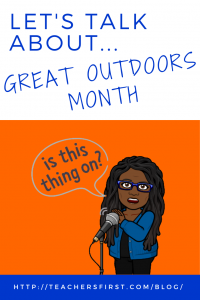June is Great Outdoors Month, a time to celebrate our local, state, national parks, and waterways. As we straddle the line between pandemic and endemic COVID-19, we need to balance safety for those still vulnerable and learning to live with COVID19 as an endemic disease. In 2020 we discussed staying close to home with your Great Outdoors Month activities. This year we want to encourage you to push back against Nature-Deficit Disorder in our students.
We’ve discussed the United Nations Sustainable Development Goals and the need to teach the SDGs. Students who spend most of their time indoors or consuming digital content may lack the connection with nature that helps them understand the importance of goals 14 and 15: life below water and life on land. Without some connection to the outdoors, students will lack the enthusiasm necessary to engage in critical conservation efforts that will pass down to the next generation.
There are many ways to help students to connect with nature. Here are a few ideas:
- The National Wildlife Federation encourages us to support a Green Hour daily by providing activities that help students connect to nature. Science tells us there are multiple benefits to getting students outside to play, including higher academic achievement. It doesn’t have to be complex. For example, you could have students practice mindfulness while forest bathing and then respond to journaling prompts about the experience. If you are a little more ambitious, you can start a garden with your students.
- Introduce students to the idea of the Owl Prowl. Use the Audubon Adventure (reviewed here) for Getting started with Owl Prowls and perhaps watch a virtual owl prowl as a class. Set up a Flipgrid to complete an owl pellet exploration. Students will then be prepared to go to their local green space (maybe with a parent/guardian), determine if an owl is there, and report back to the class.
- Engage in citizen science projects. SciStarter (reviewed here) offers free training to get started with citizen science. Use their website to find a topic that will complement your curricular needs. Project Budburst (reviewed here) shares curricular content for understanding plant life cycles, ecosystems, and scientific inquiry. The Great Sunflower project provides lesson materials surrounding sunflowers and pollinators. You can find other opportunities listed on the National Geographic educators’ website. The National Park Service also shares a list of citizen science projects on its website, and you can find other opportunities to work with national agencies here.
Are you planning to encourage your students to get outdoors? Let us know what you’ll be doing in the comments below.


